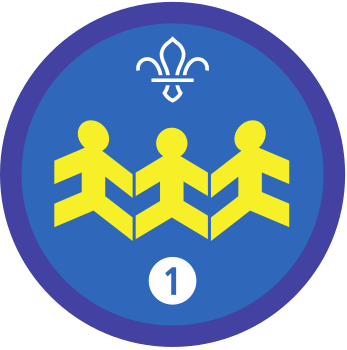
Paint Pride pebbles
You’ll need
- Paint brushes
- Permanent markers
- Paint or paint pens
- Smooth rocks (make sure you don't take these from a beach, you can get them from your garden, a DIY store, craft store or garden centre)
Before you begin
- Use the safety checklist to help you plan and risk assess your activity. There's also more guidance to help you carry out your risk assessment, including examples. Don’t forget to make sure all young people and adults involved in the activity know how to take part safely.
- Make sure you’ll have enough adult helpers. You may need some parents and carers to help if you’re short on helpers.
Planning this activity
- Remind everyone, including parents and carers, not to let their young people bring or wear anything that can’t get damaged or messy during arts and craft activities. You could ask people to bring, or provide, aprons.
- Some people may be in the process of questioning their sexual orientation or gender identity or may not have shared their identity with anyone. Make sure everyone knows they don’t have to share anything about themselves if they don’t want to. It’s important that everyone feels comfortable in this activity, as well as knowing how they can access support.
- Young people may share aspects of their identity that may be new to them, new to you or new to the rest of your group. This is a very brave thing to do, and it's extremely personal and different for everyone. Make sure you look out for these individuals and provide a safe and calm space for them to process their emotions. Make sure to model affirming responses to anything shared by your young people.
- There's a range of labels young people and adult volunteers may use to describe their sexual orientation or gender identity. For example, asexual, pansexual, nonbinary, or questioning. Take the time to research these, so you feel comfortable in your knowledge of them should a young person or adult want to discuss their sexual orientation or gender identity with you.
- It's the responsibility of all adults in Scouts to help develop a caring and supportive atmosphere where bullying in any form is unacceptable. Look out for any signs of homophobic and/or transphobic bullying and language. See our guidance on preventing and dealing with bullying. You may want to create a zero-tolerance policy towards LGBTQ+ bulling or discrimination within your Section or Group rules.
- You may want to visit our LGBTQ+ pages to find out more about supporting LGBTQ+ members in Scouts.
Setting up this activity
- You could prepare some Pride painted pebbles to show everyone or find pictures of some online to use as examples.
- You may want to run this activity outside or have table coverings to reduce mess.
- If pebbles don’t work for your group, the group could write kind, supportive messages on rainbow bookmarks and put them inside LGBTQ+ library books for others to find.
Introducing the activity
- Gather everyone in a circle. Ask if anyone knows what Pride month is.
- Explain that Pride month is a time to celebrate LGBTQ+ people and show our support for this community, though we should be doing this all year round.
- Tell everyone that you’re going to make some painted pebbles to show your support for LGBTQ+ people in your local community and hide them in the local area for people to find. If you have them, you can show examples of painted pebbles to the group.
- Explain that a lot of people may have had negative reactions, experienced bullying or abuse, or been discriminated against because they’re part of the LGBTQ+ community and this isn’t acceptable.
- Tell everyone that at Scouts, we welcome and accept everyone, regardless of gender identity or sexual orientation. By taking part in this craft and showing our support, we can celebrate the inclusion and diversity we’re so proud of. Messages of support can make a big difference for LGBT+ people. Songs, such as ‘Born this Way’ by Lady Gaga or ‘This Is Me’ from the Greatest Showman, remind people that they’re loved and accepted for who they are.
- We can also show support to the LGBTQ+ community by being non-judgemental, avoiding assumptions and being accepting of everyone, challenging language misuse and reporting any homophobic or transphobic bullying to an adult.
- Ask people what they could decorate their pebbles with. They could put on supportive messages or lyrics. They may suggest the Pride rainbow colours, or they could draw different Pride flags and symbols. They may want to create a pebble that looks like an LGBTQ+ icon or important figure. Some good examples of messages might be:
-
- Love is love
- Respect everyone
- Happy Pride
- Love yourself
- Pride
- Equality
- Empower
- Just be you
- Scouts welcomes all
- Love always wins
- #ScoutPride
- #PrideInOurValues
- Be proud
- Be yourself
- Make yourself proud
- Proud to be LGBTQ+
Painting the pebbles
- Give each member of the group a pebble – or several, depending on the size.
- They may want to draw out what they’re writing or creating in pencil first. When they’re ready, they should begin painting it.
- People could come together as a group, or in small groups, and create a letter each to write a supportive message for LGBTQ+ people as part of a pebble display to place in your local community, rather than creating separate pebbles.
- If they take a while to dry, everyone could play a quick game while they dry.
Placing the pebbles
- Everyone should decide whether to place the pebbles somewhere in the local community or whether to give them to someone else.
- You could run another session where everyone gets a chance to put the pebbles in the local area for people to find.
- You could leave a note with the pebbles to say they’re from your Scout Group with a message of support. You could also write your Scout Group name on the back.
Reflection
This activity was about doing something to show our Pride and support the LGBTQ+ community. Encourage the group to think about the pebbles they made.
What impact could the pebble have on people who see it? How would you feel if you found one of these pebbles? If you are LGBTQ+, how would it make you feel? If you are an ally to the LGBTQ+ community, how would it make you feel? People do not need to share their reflection with the group if they don't want to.
Why do you think people in the LGBTQ+ community might need to feel more accepted, especially by wider communities?
Safety
All activities must be safely managed. You must complete a thorough risk assessment and take appropriate steps to reduce risk. Use the safety checklist to help you plan and risk assess your activity. Always get approval for the activity, and have suitable supervision and an InTouch process.
- Craft: Unusual substances
Supervise young people appropriately when they’re using unusual substances, such as powdered paint, ash or dirt. Be aware of any medical conditions that could be affected by what’s being used. Make sure you follow all relevant safety guidance or manufacturers guidelines, where available. Make sure you dispose of it appropriately too, in line with safety guidance.
- Visits away from your meeting place
Complete a thorough risk assessment and include hazards, such as roads, woodland, plants, animals, and bodies of water (for example, rivers, ponds, lakes, and seas). You’ll probably need more adult helpers than usual. Your risk assessment should include how many adults you need. The young people to adult ratios are a minimum requirement. When you do your risk assessment, you might decide that you need more adults than the ratio specifies. Think about extra equipment that you may need to take with you, such as high visibility clothing, a first aid kit, water, and waterproofs. Throughout the activity, watch out for changes in the weather and do regular headcounts.
- If anyone struggles with fine motor skills, they could use larger materials. People may struggle to hold pens, paintbrushes or pencils to write with. You could swap out the items for something easier to handle. You could use different objects for people to craft, paint, draw or print with, so there’s a range of items for people to be able to grip and hold.
- People could also work with a partner or in a small group, so they can help each other. For example, they could help with drawing or writing out the phrase, or carrying, placing down and lifting the people.
- If you’re putting the pebbles somewhere as a group, choose an area or terrain that’s suitable for all members of your group. You could visit the area early and remove any large or obvious obstacles. Make sure the location and route you plan is accessible for everyone.
All Scout activities should be inclusive and accessible.


